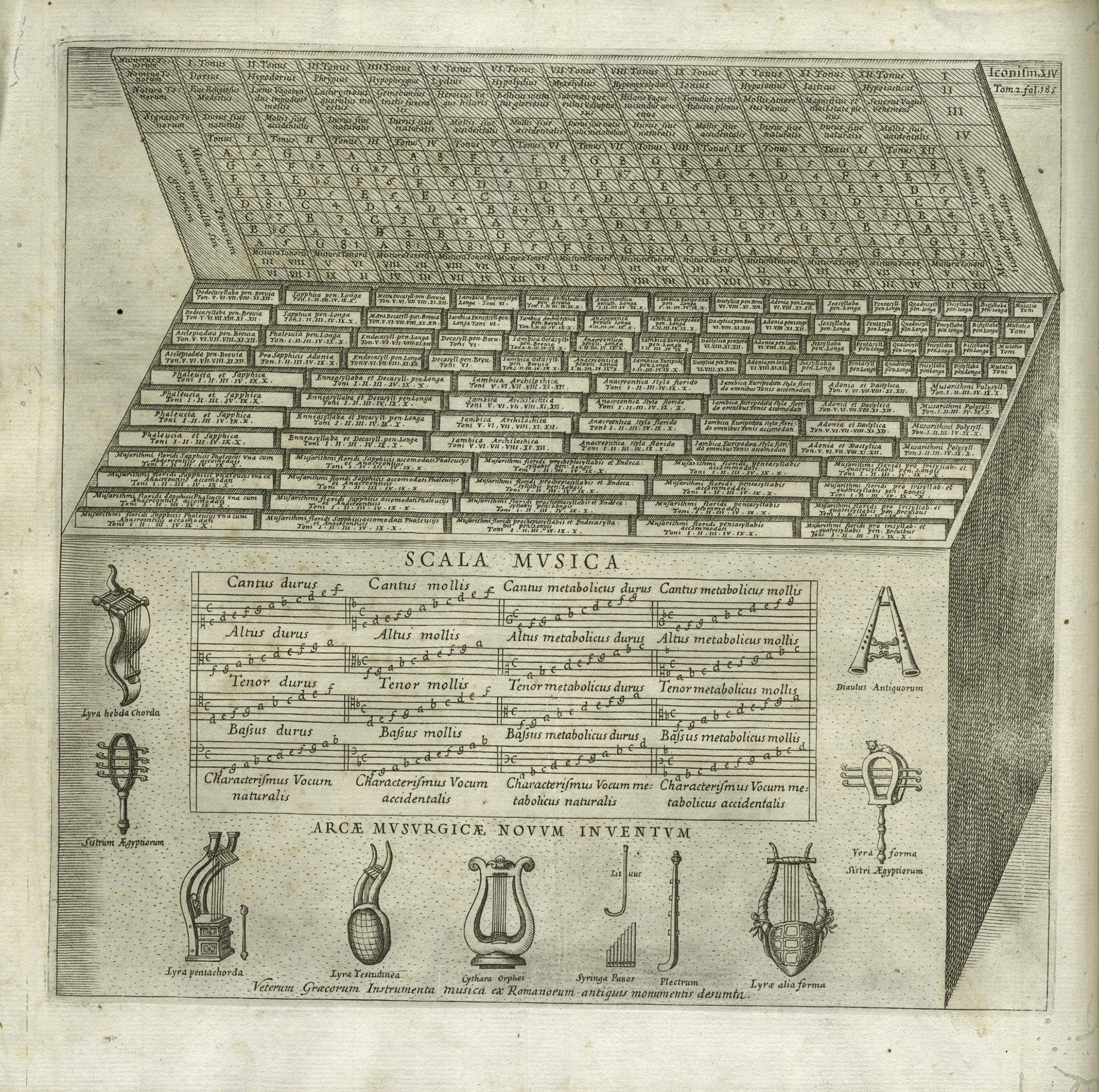The first device for algorithmically composing music comes to us surprisingly early: in the 1600s. Looking something like an overcomplicated and miniaturized chest of drawers, it allowed even complete amateurs to compose four-part church music. They could start with a text in verse to set to music, choose whether they wanted music in a simple or florid style, and the rest was achieved by mixing and matching the entries carved into the device’s many little wooden tablets, ultimately converting the results into musical notes.
Only a few examples of the device, known as the Arca musarithmica or “Musical Ark,” remain today. The famous diarist Samuel Pepys owned one, as did Ferdinand III of the Holy Roman Empire. If you want to play with one yourself, however, you won’t have to break into an archive; musicologist Andrew A. Cashner has created a digital version.
The idea for the device came from polymath and all-around oddball Athanasius Kircher, who first presented it in his exhaustive and eclectic treatise Musurgia universalis. As historian of music Jeffrey Levenberg suggests, the title is a clue to its ambitious scope, and indeed, Kircher covers almost everything that even vaguely relates to music: birdsong, the structure of the inner ear, the echoes produced by different shapes of rooms. There is even an odd aside in which he describes the beautiful singing of the American sloth:
It perfectly intones the first elements of music, Ut, re, mi, fa, sol, la; la, sol, fa, mi, re, ut in such a way that the Spanish, from the moment they first possessed those shores and heard by night the distinct calling of this kind, thought that they were hearing human beings trained in the rules of our art of music.
Kircher was also a wide-ranging inventor, and the Arca musarithmica is sandwiched among a number of other peculiar designs: a harp played by the wind, a method for making statues seem to speak by setting them in front of concealed tubes that amplify chatter from the street outside, a canon that can be sung by twelve million two hundred thousand voices.
To a modern mind, these sonic phenomena might seem scattered and disconnected, but Kircher’s worldview knit them all together as reflections of the essential, underlying harmony of the universe. Indeed, in one illustration, he represents the creation of the world as if it was being played into existence on a gigantic organ, with the firmament, the land and the waters, and the animals and plants all emerging from different pipes. Peculiar though it appears, the anecdote about the singing of the sloth fits neatly into this worldview; it demonstrated that even exotic, savage beasts partook in the cosmic chorus.

What does that tell us about his odd music-making algorithm? Historian of music theory John Z. McKay writes that Kircher was inspired by another polymath, Marin Mersenne, who proposed that the best of all possible songs could be discovered by considering every permutation of the basic notes “Ut–Re–Mi–Fa–Sol–La.” (The same notes the sloth supposedly likes to sing!)
Unfortunately, the music produced by the Arca musarithmica tends to be bland and uninspiring—but it’s the theory that matters here. In this vein, there are telling similarities between the device and the work of Ramon Lull, a thirteenth-century Spanish mystic who was one of Kircher’s key influences. Lull produced a combinatorial device called the Ars Magna or Lull’s Art, a system of paper wheels which he believed could be used to uncover new truths.
As artist and critic Janet Zweig writes in “Ars Combinatoria: Mystical Systems, Procedural Art, and the Computer,” Lull’s system is
enormously complex, but put simply, it employs letters of the alphabet as symbolic notation for Divine attributes; the letters are placed on revolving wheels and can then be mechanically combined with other data in order to solve problems. Lull believed his Art could be applied to all fields of knowledge and was therefore a truly universalist system.
For Kircher, who depicted Genesis through pipe organ, there was probably a hint of the mystical to the Arca musarithmica, an echo of Lull’s “universalist system.”
Weekly Newsletter
Kircherthought like an alchemist, and so his comprehension—and revelation—of the structure and order of the universe wasn’t “necessarily linear or hierarchical, or necessarily based on inductive reasoning, but was closer to the anagrammatic manipulation of the permutation tables.” Musicologist Margaret Murata writes that Kircher
distilled music down to its “simples,” which could then be combined—and transformed. […] Every fact and detail that could be taken into the system could only improve the chances that a crystal would precipitate out, that a pattern in the mosaic would emerge.
Murata draws on the more familiar (to us) Rubik’s cube to explain Kircher’s understanding of the universe, of which “sounding music is a version.” On the face of each cubelet is a representation. “Transformation happens when you arrange and rearrange the representations,” Murata writes, “coming up with useful or just curious patterns and relationships—until all the tiles line up and you find the pattern that God intended.”
The way we use the word “harmony” to refer to justice, cooperation, and goodness—all things acting rightly—was more than a metaphor to Kircher. In the proportional relationships of notes and chords, there was a hint of the underlying nature of the universe; in the endless permutational potential of the Arca musarithmica, there was a hint of God’s creative power.
Support JSTOR Daily! Join our membership program on Patreon today.







